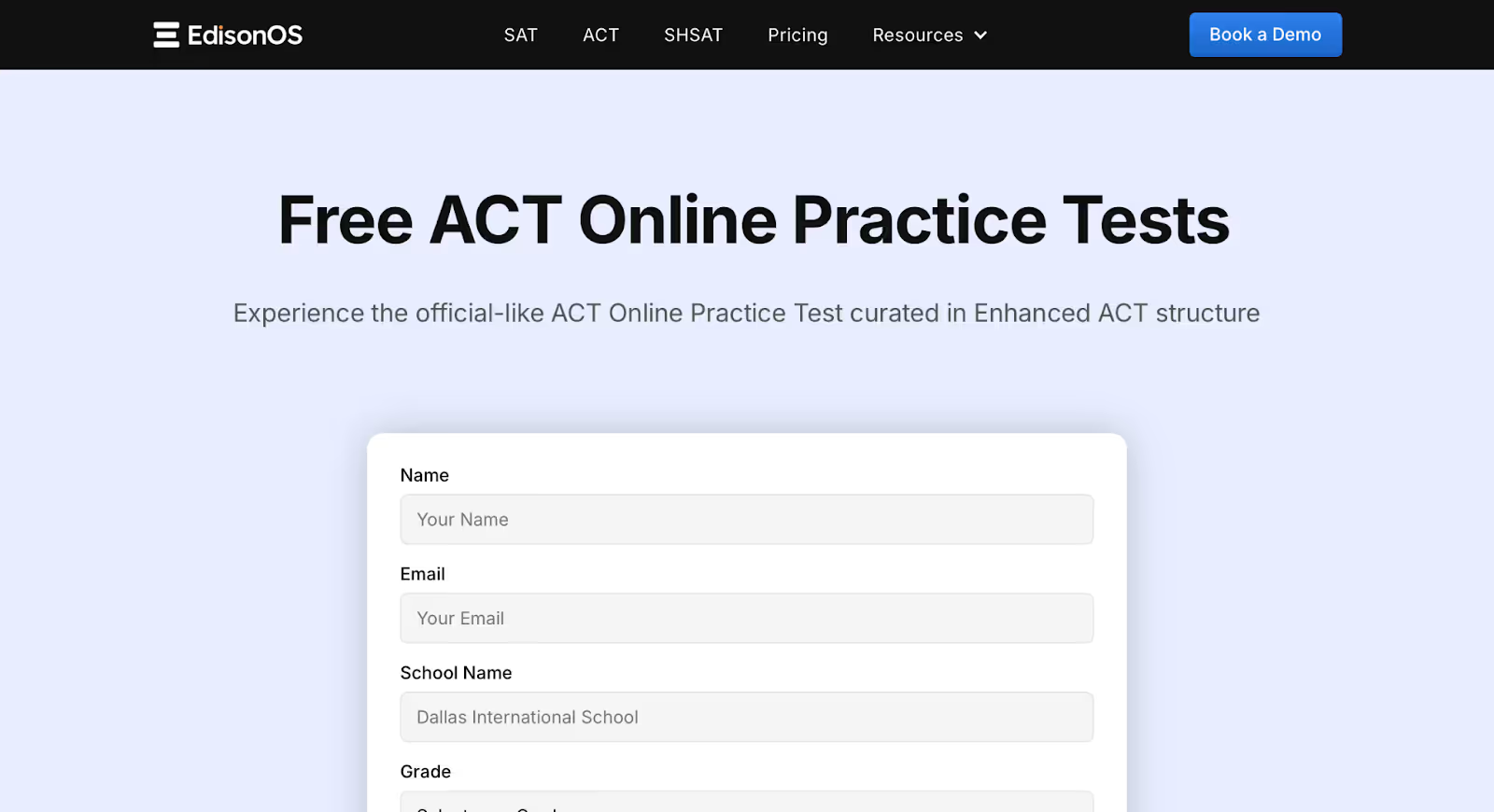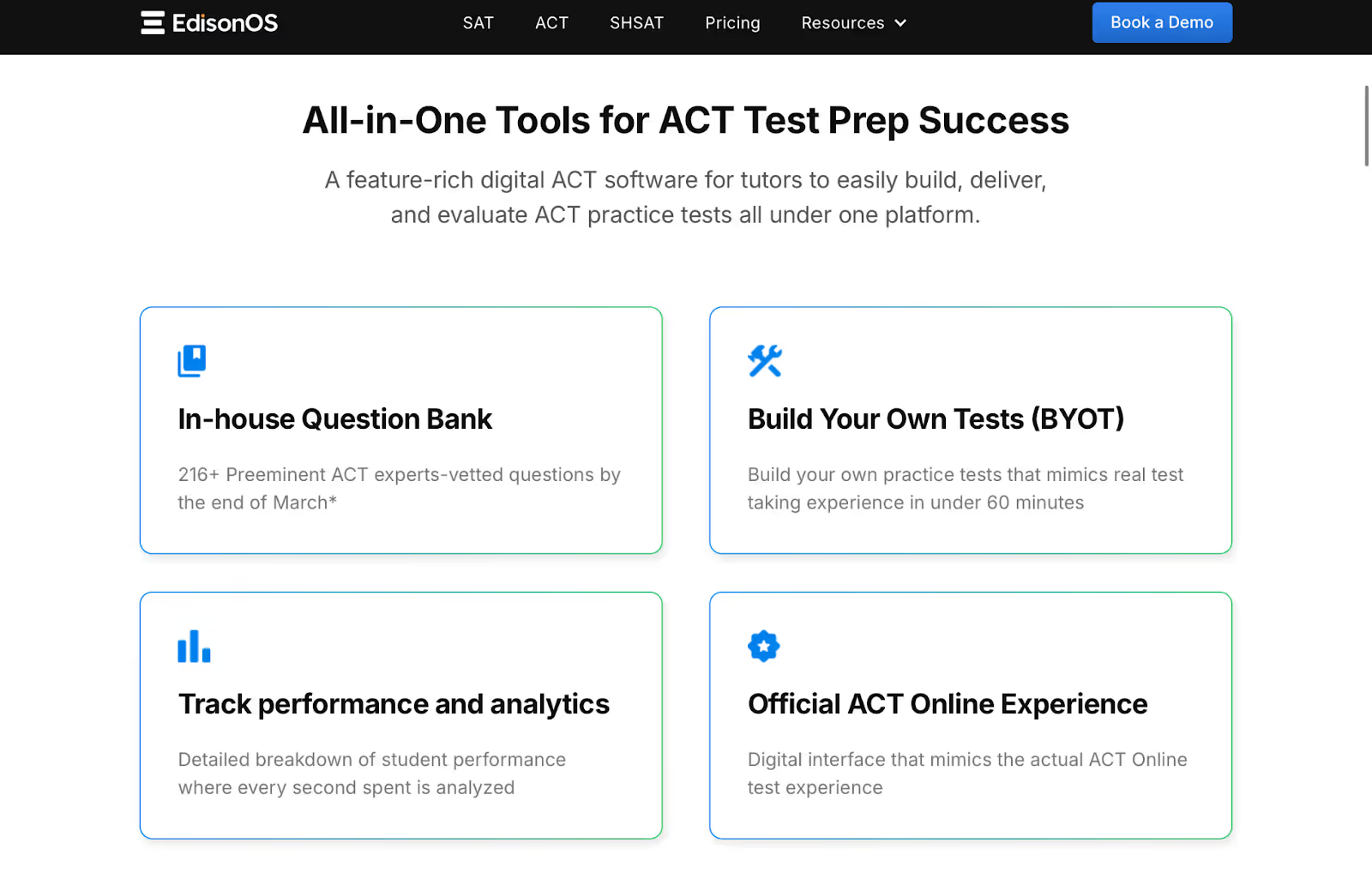




Key Takeaways
- Superscoring averages your best section scores across test dates for a higher composite.
- Not all colleges accept superscores—check each school’s admissions policy before sending.
- Strategic retakes and section-focused prep can significantly boost your ACT superscore.
Superscoring means averaging your highest section scores from all the ACT tests you’ve taken to create a new, higher composite score. Unlike a standard ACT composite (which comes from one test sitting), a superscore is a “super” composite that showcases your best performances in each subject across multiple test dates.
Students and parents are asking about superscores because it can highlight a student’s peak abilities on the ACT, potentially strengthening college applications and scholarship opportunities.
With many colleges now considering superscores, it’s important to understand how this works and how to use it to your advantage.
What is an ACT superscore?
An ACT superscore combines your highest section scores across different test dates into one new composite.
The ACT has four sections: English, Math, Reading, and Science. Normally, your composite is the average of all four from one test.
With superscoring, you take the best score in each section, no matter the test date, and average those to get a new, higher composite.
Why it matters
Superscoring shows colleges your best possible performance. It helps if your scores go up in some sections but down in others when you retake the test.
Many students use this to improve their score without needing to be perfect in one sitting. In fact, ACT’s own data says superscores are better at predicting college success than single-test scores.
Note: Starting in late 2025, the ACT composite will only include English, Math, and Reading- Science will be excluded from the superscore. Until then, all four sections count. Check ACT.org for updates if you're testing during this change.
How to calculate your ACT superscore
Here’s a simple formula:
- Add up your highest scores in each ACT section (English, Math, Reading, Science) and then divide by 4.
- Round that result to the nearest whole number.
- The result is your superscore composite.
Step-by-step superscore calculation:
- Gather all your ACT score reports. List out your section scores (English, Math, Reading, Science) for each test date. For example, maybe your first ACT was 21 English, 27 Math, 25 Reading, 24 Science; your second ACT was 23 English, 24 Math, 26 Reading, 27 Science.
- Pick the highest score in each section. From the example above, your best English is 23 (from the second test), Math is 27 (from the first test), Reading is 26 (second test), Science is 27 (second test). Circle these best scores.
- Calculate the average of these four best scores. Add them up: 23 + 27 + 26 + 27 = 103. Divide by 4, which gives 25.75.
- Round to the nearest whole number. 25.75 rounds up to 26 as your superscore composite. (The ACT rounds .5 and above up to the next whole number.)
The optional essay isn’t included in this score.
ACT also has a superscore calculator on their site. Use it after each test to see if your overall score has improved. This can help you decide whether to retake the test.
💡 Example:
Aryan got 24 in Math and Science, and 20 in English, 22 in Reading on his first test (composite ~22). On his second try, she got 25 in English and 24 in Reading but lower Math and Science scores. His superscore combines the best of all: 25, 24, 24, and 24- which averages to 24.
The difference between the ACT composite score and the superscore
It’s easy to confuse a standard ACT composite score with a superscore, so let’s explain the difference.
Your ACT composite score is the average of the four section scores on one ACT test attempt. Every time you take the ACT, you get an English, Math, Reading, and Science score (each out of 36).
Those four are averaged to produce your composite for that single test date.
A superscore, on the other hand, is not tied to one test date. It’s an ACT composite that’s calculated using your highest section scores from multiple test dates.
Think of it as your personal best in each category.
Using the earlier example, maybe on a second test you scored higher in Science even if other sections were lower. Superscoring would take that new higher Science score and combine it with the best English/Math/Reading from the first test to give you an improved composite.
Composite = one-test average; Superscore = best-of-all-tests average.
Another difference is in how they’re reported and used.
Your composite score is attached to a specific test date on your score report. A superscore is a separate line on your ACT score report (if you’ve taken the ACT more than once) that ACT calculates once you have at least two sets of scores.
When you send scores to colleges, you can choose to send a single test date or an ACT superscore report. The superscore report will show the superscore composite and which section scores contributed to it, along with at least one full test score report (typically the date with your highest composite). That way, colleges see the context of your superscore.
Do all colleges accept ACT superscores?
Not all colleges accept ACT superscores. While many institutions allow students to submit a superscore (which combines the highest section scores from different test dates), it’s important to check each college's policy on superscores. Some colleges only accept the composite score from one specific test date, while others will consider the superscore as part of your application.
In general, colleges that accept superscores typically see them as a way to showcase a student’s best performance across multiple test attempts. This flexibility can benefit students who may have performed unevenly on different sections of the test across multiple sittings. Some schools still only use the ACT composite score, which is the average of the scores from a single test date.
Colleges that accept ACT superscores include Harvard University, Yale University, Stanford University, University of Chicago, and University of Pennsylvania. However, Harvard and Princeton do not accept superscore ACT results.
Given the mixed-to-negative reactions surrounding the new enhanced ACT test (especially with issues like technical glitches and difficulties with the math section), colleges are taking a cautious approach with respect to the new format and its potential for superscoring.
While some admissions teams might find the new version of the test easier, the overall uncertainty around the reliability of scores from the Enhanced ACT may cause some institutions to pause or limit their acceptance of this format, including superscores, until the issues are resolved.
Therefore, it’s essential to check the specific policies of the colleges you're applying to, especially in light of the new digital format and its scaling challenges.
What if a college doesn’t superscore?
If a college doesn’t superscore, it means they will only consider the composite score from a single test date. In this section, we’ll explore some alternatives and strategies for navigating this scenario.
1. They usually consider your best composite score.
If a school doesn’t superscore, they’ll likely use the single test date where you got your best composite score. This still means retaking the ACT can help you, not for superscoring, but for submitting a stronger all-in-one score.
Some schools also allow “Score Choice.” That means you can choose which test date scores to send. If you're stronger in Math and applying to a STEM program, send the date with your best Math score. Even without superscoring, strategy matters.
2. Watch out for “send all scores” policies.
Some colleges require that you send all your ACT test scores. That means they’ll see every test you’ve taken, even if some scores were lower. This can matter if you take the test many times and show big inconsistencies.
Check each school’s score reporting policy.
What do colleges look for in a superscore report?
If you ask ACT.org to send a superscore report, here’s what a college gets:
- Your ACT Superscore (the average of your best section scores)
- The full score details from one full test (the one with the highest composite)
- Any other test sections that were used in the superscore
So colleges still see the breakdown. If they accept superscores, they’ll focus on the best sections. If they don’t, they’ll use the highest single test score shown in the report.
Superscoring does not hide lower scores. Colleges will see the data, but most won’t penalize you for it, especially if they’ve said they superscore.
Benefits of ACT Superscoring
ACT superscoring offers several advantages, allowing students to showcase their best section scores across multiple test dates and potentially improve their overall score.
1. Higher scores = better chances
Superscoring often gives you a higher ACT score than any one test. Even a 1-2 point bump can help with college admissions or scholarship eligibility. Colleges get to see your best work, and you get to submit the strongest score possible.
Over 80 merit scholarships list ACT cutoffs in 1-point increments, so moving from, say, 29 to 30 could unlock awards worth thousands more per year.
2. Less test anxiety
Knowing that your best section scores will count reduces pressure on test day. If one section goes badly, your better score from another test can make up for it.
An ACT study found a strong negative link (r = –0.30) between self-reported test anxiety and ability, driven largely by feeling unprepared rather than innate bias.
3. Focus on progress, not perfection
You can improve one section at a time. A great Math score from one test and strong English from another will both count. Superscoring rewards steady improvement.
Research comparing scoring methods for nearly 1 million students showed superscores predict timely degree completion as well as—or better than—using students’ most recent (r ≈ 0.41) or average composite (r ≈ 0.39) scores.
4. Fair and accurate
ACT research shows superscores better predict college success than single test scores. Superscoring is fair to students across backgrounds and gives colleges a fuller view of your ability.
A 2019 ACT white paper compared four score-use policies across thousands of retesters and found that superscoring produced the smallest prediction error for first-year GPA, outperforming “most recent,” “highest,” and “average” composites. Follow-up analyses showed superscoring did not widen subgroup performance gaps—in fact, it slightly narrowed them—demonstrating equity across genders, ethnicities, and income levels.
5. More scholarship options
Many scholarships have ACT cutoffs. Superscoring might push you over the line. For example, if you score 29 twice but superscore to 30, that could qualify you for a better award.
For instance, Air Force ROTC scholarships start at a 26 composite, state “eminent” grants at 29, and top university fellowships at 33. By pooling your best section marks into a superscore, you boost the chance of clearing multiple cutoff bars, making you eligible for a broader range of merit-based funding.
How to strategically plan for superscoring
If you plan to use superscoring to your advantage, you’ll need a smart testing strategy. Here are some tips on how to plan your ACT attempts and preparation:
1. Take the ACT more than once
Most students stop after three sittings, since gains taper sharply beyond that.
The biggest jump happens between your first and second ACT—one example student rose from a 23 composite in February to 24 in April, then hit a 25 superscore by combining their top section scores across both dates.
After three tests, average composite gains fall below 0.5 points, making further retakes less cost-effective.
2. Space out your test dates
Allowing a window of three to four months between exams gives you time to analyze results, drill weak areas, and rebuild stamina.
For example, one r/ACT user spaced sittings in February, June, and September, using each score report to target their weakest section. Their per-test section highs looked like this:
- Test 1 (Feb): Math 23, English 24, Reading 25, Science 22 (composite 24)
- Test 2 (Jun): Math 26, English 27, Reading 28, Science 24 (composite 26)
- Test 3 (Sep): Math 28, English 29, Reading 30, Science 26 (composite 28)
3. Tackle one section at a time
Research shows superscores (r = 0.41) predict first-year GPA more accurately than averaging all composites (r = 0.39), underscoring the value of section-specific gains.
Case in point: on a popular r/ACT thread, one student posted these three sittings—
- Test 1: Math 33, Science 34, English 35, Reading 35 (composite 34)
- Test 2: all sections 30 (composite 30)
- Test 3: Math 35, Science 36, English 20, Reading 20 (composite 28)
By superscoring their best section marks (Math 35, Science 36, English 35, Reading 35), they earned a 35 superscore—one full point above their highest single-test composite.
4. Practice with diagnostics
Take full-length ACT practice tests. Review your section scores after each one. Note the question types or topics where you struggle. Use those insights to guide your prep Use online platforms like EdisonOS to structure your plan.

5. Be smart about sending scores
Some colleges let you choose which test dates to send. For superscoring schools, send all test dates that had your highest section scores.
If a college doesn’t superscore, send the highest composite score. Keep track of all your scores so you can make quick decisions during application season.
6. Don’t forget about costs
Each ACT attempt costs money. But fee waivers are available for eligible students.
ACT lets you send up to 20 score reports free with a waiver. Don’t let cost stop you from improving your score. Ask your school counselor about fee waivers if you need one.
Common Misconceptions About ACT Superscoring
Myth #1. "Superscoring is cheating or inflating my scores."
Superscoring doesn’t alter or create new results; it simply highlights your top performances.
Research conducted by ACT found that using superscores predicts first-year college GPA more accurately than relying on a single-date composite, the most recent composite, or the average of all composites
The same studies show superscoring does not advantage or disadvantage any demographic group. Differences in performance between genders, ethnicities, and income levels remain consistent whether you use single-date scores or superscores.
After empirically evaluating various score-use policies, ACT formally endorses superscoring for admissions decisions, confirming its validity and fairness.
By combining your best section scores, superscoring doesn’t inflate your abilities—it simply presents the most accurate reflection of your strengths.
Myth #2. "All colleges superscore, so I don't need to check."
Many colleges superscore the ACT, but not all institutions do. You can’t assume blanket superscoring across the board.
The list of schools that superscore is growing, yet it isn’t exhaustive. For example, over 200 schools reported “superscoring across all sittings” to The Princeton Review, but dozens more may have different policies or may change theirs without notice.
Some colleges still consider only your highest composite from a single test date or require submission of all scores—so a one-size-fits-all assumption can backfire.
How to confirm a college’s superscore policy:
- Visit the institution’s official admissions website.
- Locate the “Testing Requirements” or “Admissions FAQs” section.
- Search for keywords like “superscore,” “score choice,” or “highest section scores.”
- If the policy isn’t clear, email or call the admissions office directly.
Why verifying matters
- Sending only your highest composite to a non-superscoring school could omit stronger section scores that would benefit you.
- Conversely, over-sending reports to a superscoring college without needing to could rack up unnecessary fees.
- Knowing each school’s exact policy lets you tailor which scores to send, maximizing your application strategy.
Myth #3. "Colleges won’t see my other scores if I superscore."
When you send an official ACT superscore report, colleges receive your highest section scores for English, Math, Reading, and Science, plus the actual scores and dates for every test sitting that contributed at least one top-section score to that superscore.
Tests that didn’t contribute any best-of-four sections won’t appear on the superscore report—but any date that did is fully visible, section by section.
Superscore reorganizes data from the dates you send, spotlighting your best sections—but it does not delete or obscure those section-level results.
Score Choice is a separate ACT feature letting you pick which entire test dates to send. If you use Score Choice to withhold a full test date, colleges won’t see any scores from that sitting.
Some colleges require applicants to submit all ACT test dates—superscoring or not—so they’ll automatically see every score you’ve ever sent.
Other schools allow Score Choice, meaning you can elect to send only the dates you want considered.
Always confirm each institution’s testing policy on its admissions website or by contacting the admissions office directly. That way, you control which dates and section scores they actually see.
Myth #4. "I should take the ACT as many times as possible."
Students can register for the ACT with no formal limit on total sittings. In practice, most test-takers opt for two to three attempts to hit their target score.
Studies show the largest score bump happens between the first and second test date. After three tries, average score gains taper off sharply, making additional attempts less cost-effective
Admissions officers may view many retakes as a sign of over-prep or chasing points rather than genuine mastery. Each registration incurs fees (currently $63–$68 per sitting), plus optional report-sending charges. Repeated testing can cause burnout, diverting time from other application components like essays and extracurriculars.
A smarter retake strategy:
- Establish a Target Score
- Research the 25th–75th ACT percentiles for your colleges of choice.
- Evaluate after each test
- Drill down on section-level weaknesses before booking your next date.
- Focused prep, Not quantity
- Use high-quality practice materials or targeted tutoring to maximize per-test improvements.
- Cap attempts around three
- Plan for up to three sittings: one baseline, one major prep push, and a final “polish” test if needed
By prioritizing deliberate practice over unlimited retakes, you conserve resources, avoid admissions red flags, and make each attempt count.
Myth #5. "I can relax on other sections during retakes."
You must retake the entire ACT exam each time (unless you opt into limited section retesting that begins online in Fall 2021), so any section you neglect still factors into your composite.
Even with section retesting, you can only retake up to three of the four sections in one sitting; the un-retested section score stays as is and counts toward your superscore.
Why balanced prep pays off
- The ACT composite is an average of four section scores; boosting one won’t fully offset neglect in another.
- Regular practice across all sections builds test-day stamina and confidence.
- Holistic review helps you identify cross-section skills (time management, stress resilience) that benefit every module.
Tips for well-rounded retakes
- After each test, drill down on only your lowest-scoring section and maintain polish on your strongest ones.
- Schedule full-length, timed practice exams to simulate real conditions and catch pacing issues early.
- Use sectional goals: set a target score for each module so you know exactly where to focus before the next test date.
By preparing all four sections deliberately, you ensure each retake maximizes both your composite and superscore potential.
How EdisonOS can help you boost your ACT score
Planning for superscoring takes the right tools. EdisonOS makes it easier to track, practice, and improve one section at a time.

Assessment Tools
Build Your Own Tests (BYOT)
– Create tests in 15 minutes using our 5,000+ question library or in 60 minutes with your own questions
– Slashes tutor assessment prep from ~35 hours/week to just 2–3 hours
Bulk Upload
– Import hundreds of questions at once via a formatted Excel file
– Instantly adds items to your question library for on-demand test creation
AI Question Extraction
– Upload PDFs or images; AI extracts questions, options, answers, and explanations
– Eliminates manual entry and accelerates content digitization
Tutor Mode
– While students test, incorrect responses trigger immediate answer keys and explanations
– Reduces weekly review sessions to strategy and progress discussions
Offline Mode
– Download PDF tests and OMR bubble sheets for paper-based practice
– Students enter answers digitally afterward to receive full scaled scores and section breakdowns
Public Assessments
– Generate shareable links for school diagnostics or lead-gen events
– Run proctored group tests for 100–300 students and capture new enrollments
Digital Interface
– Mimics any standardized or state test screen-by-screen, including calculators, highlighters, zoom, flagging, timers, and proctoring
– Familiarizes students with official exam tools and pacing
Study Plan Features
Diverse Question Formats
– Assign table-entry, fill-in-the-blank, drag-and-drop, and more
– Mirrors evolving digital test formats so students master every interaction before test day
Live Sessions
– Schedule and host one-on-one or group lessons via built-in video
– Streamlines setup and integrates session data with diagnostics for targeted feedback
Reporting & Analytics
Detailed Summary
– Instant scaled score, section and skill analysis, time-per-question, and session logs
– Customizable raw-to-scaled conversions and automated parent/guardian email reports
Question Analytics
– Reveal each student’s answers vs. correct answers, time spent, peer-accuracy rates, and difficulty levels
– Powers motivational group reviews and precise, data-backed coaching
Make ACT superscoring work for your students
Superscoring turns each ACT sitting into a precision tool for your students: they tackle one section at a time, you compile their top performances, and together you submit the strongest composite to colleges. As a tutor or tutoring firm, your role is to orchestrate that process—spacing retakes strategically, drilling weaknesses efficiently, and interpreting score reports with confidence.
Remember that test results are only one facet of a student’s profile. While you help them perfect their ACT superscore, they still need solid grades, compelling essays, and meaningful activities to stand out.
EdisonOS unifies official practice tests, adaptive diagnostics, and instant analytics in a single white-label platform. It frees your team from administrative overhead, sharpens your instructional focus, and powers data-driven decisions at scale.
You can book a demo with EdisonOS today to get started.
Frequently asked questions
A superscore takes your highest section scores from different ACT test dates and averages them into a new composite. The report includes: - The superscore composite - The individual best section scores used Full score details from at least one full test (often your highest composite)Writing scores are not included, as they’re not part of the composite. Colleges that accept superscores will use the composite; others will look at your best full test.
No. Many do, including top schools like Yale, MIT, and NYU. But others, like Harvard, Princeton, and Georgetown, don’t. Some public systems (e.g., UC schools) also don’t superscore.Always check each college’s official testing policy. If it’s unclear, assume they don’t superscore until confirmed.
Yes- at least all the test dates that contributed to your superscore. ACT’s official superscore report includes those scores automatically.If a college requires all scores, you must send them all. If not, you can choose what to send (Score Choice). Just make sure you send every test that helps your superscore.
If your superscore is higher than your best one-time composite, then yes- it’s better. Colleges that superscore treat your superscore as your actual score. If your best score and superscore are the same, either one works. For colleges that don’t superscore, only send your best full test.
Yes- and it’s a smart move. Many students retake the ACT to improve just one or two sections. Superscoring combines your best scores, so each section boost helps. Just don’t ignore the other sections during retakes. And keep retakes to 2-3 times with solid prep in between.
Tutors Edge by EdisonOS
in our newsletter, curated to help tutors stay ahead!
Tutors Edge by EdisonOS
Get Exclusive test insights and updates in our newsletter, curated to help tutors stay ahead!
Recommended Reads
Recommended Podcasts






.png)




.png)
.webp)
